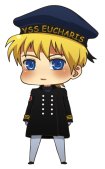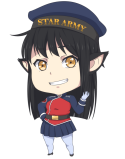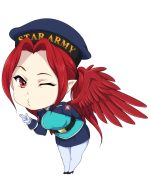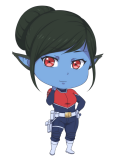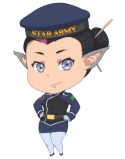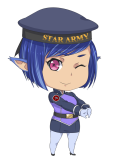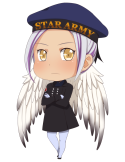Table of Contents
YSS Sakura II Roster, Roles, and Rules
This page contains data on the YSS Sakura II Plot's current and former crew rosters, cabin assignments, open roles, joining requirements, and the IC and OOC rules.
Available Positions
- For a list of openings see Characters Wanted
Roster
These are the current crew of the YSS Sakura II, as well as their cabin assignments. Former crew are also listed here.
Current Crew
These are the currently serving crew of the YSS Sakura II, listed in order of descending rank. Due to the CO's interest in making his crew more versatile, personnel are permitted to have secondary roles to both expand their skills and participate in various roles should the need arise.
Officers
| Rank | Name | Primary Position | Secondary Positions | Color | Player | Orders | Notes | |
|---|---|---|---|---|---|---|---|---|
 | Taisa | Kage Yaichiro | 10A Starship Captain | 09 Starship Operator |  | Toshiro | Orders | GM NPC, Veteran of YSS Sakura/Eucharis/Asuka |
 | Chusa | Kotonoha Miyako | 10B First Officer | 09 Starship Operator; 01C Infantry, Starship, Armored |  | Miyako | Orders | Veteran of YSS Asuka, Former UOC Peacekeeper |
Warrant Officers
No Warrant Officers are assigned to the Sakura II at this time.
Non-Commissioned Officers
| Rank | Name | Primary Position | Secondary Positions | Color | Player | Orders | Notes | |
|---|---|---|---|---|---|---|---|---|
 | Nitô Heisho | Akamaru Datenshi | 01C Infantry, Starship, Armored | N/A |  | Sageshooter | Orders | |
 | Nitô Heisho | Tanaka, Yoshiro | 01C Starship Operator | 01C Infantry, Starship, Armored |  | Yoshiro Tanaka | Orders | |
Enlisted Personnel
| Rank | Name | Primary Position | Secondary Positions | Color | Player | Orders | Notes | |
|---|---|---|---|---|---|---|---|---|
 | Jôtô Hei | Koyama | 05 Maintenance Technician | 05D Chief Engineer (Acting) |  | Soresu | Orders | Sister of Kotori |
 | Jôtô Hei | Aradia Shan | 07 Scientist | 01C Infantry, Starship, Armored |  | Arbitrated | Orders | Science Birb |
 | Jôtô Hei | Kayoko Shii | 13A Starfighter Pilot | 05B Starfighter & Shuttle Technician |  | paladinrpg | Orders | Appears lazy, but is she really? |
| | Corporal | William Winfield Black-Marx | 01C Infantry, Starship, Armored | N/A |  | SirSkully | Orders | Acting Jôtô Hei in Star Army Exchange Program, New Character |
 | Ittô Hei | Darren Leverton | 01C Infantry, Starship, Armored | N/A |  | Firebrand | Orders | Good Ol' Boy |
 | Nitô Hei | Fury Powers | 01C Infantry, Starship, Armored | N/A |  | Toshiro | Orders | NPC |
 | Nitô Hei | Taharial Chasan | 08 Medic | N/A |  | Bloodyscarlet | Medic Birb | |
| Santô Hei | Russ Tycho | 13A Starfighter Pilot | N/A |  | Scherersoban | Orders | Former civilian cargo freighter pilot | |
Cabin Assignments
A total of 22 large crew cabins on the vessel, with two beds each. This can be increased to four or even replaced with a Star Army Nekovalkyrja Nest/Life Raft, Type 40 if needed. Eighteen of the rooms are on Deck 2, and four are on Deck four where bridge crew and essential engineering staff reside. The Commanding Officer and First Officer have separate suites of their own on Deck 3, above the Bridge. There are also two suites for VIPs on Deck 3. A Chief Cabin and two Star Army Half-Century Barracks (Plumeria Type) exist on Deck 5 for guest occupancy.
Characters who aren't on this list needn't wait for permission before obtaining an unoccupied room and placing themselves there. If there were no open rooms, they will have to be roommates with another character. Permission for this must be obtained in the OOC thread. Choose wisely, because changing rooms requires the consent of the Commanding Officer and an explanation for the move.
| Cabin | Occupants |
|---|---|
| D2-01 | William Winfield Black-Marx |
| D2-02 | Akamaru Datenshi |
| D2-03 | Fury Powers |
| D2-04 | Aradia Shan |
| D2-05 | Darren Leverton |
| D2-06 | Kayoko Shii |
| D2-07 | Russ Tycho |
| D2-08 | Vacant |
| D2-09 | Vacant |
| D2-10 | Vacant |
| D2-11 | Vacant |
| D2-12 | Vacant |
| D2-13 | Vacant |
| D2-14 | Vacant |
| D2-15 | Vacant |
| D2-16 | Vacant |
| D2-17 | Vacant |
| D2-18 | Taharial Chasan |
| D4-01 | Tanaka, Yoshiro |
| D4-02 | Koyama |
| D4-03 | Vacant |
| D4-04 | Vacant |
| CO's Suite: | Kage Yaichiro |
| XO's Suite: | Kotonoha Miyako |
Former Crew
- Nausicaa Fairchild, Gunsight1 and Yoshi, Former Commanding Officer & GM
- Takeshi Saba, ArsenicJohn
- Yamashiro Sakura, Gunsight1
- Bast Garu, Zack
Basic Requirements
The YSS Sakura II is a plot that usually requires a face to face or tele-presence interview with the commanding officer over PANTHEON, unless the commanding officer has had previous dealings with the person involved. It does not require previous experience, but those lacking previous experience may be required to do a significant amount of reading. The ship will accept most races participating in the Empire; though digital-brained races such as the NH-22C Yamataian, the NH-29, Minkan, and the Nekovalkyrja, Type 33 tend to be favored for piloting or infantry roles due to their resiliance and capability of utilizing security organs and more advanced interfaces. In some cases, NH-27 Nekovalkyrja may also be accepted.
The YSS Sakura II is a ship which is multi-purpose, one of the “jack-of-all-trades” craft, and thus its personnel must be flexible. New technologies, various types of missions with and without support, changing locations, and other unexpected elements are intended to be common. While a soldier may find themselves applying for one duty, they may benefit from a degree of cross-training in additional disciplines if they find themselves capable of doing so.
Rules
These are in-character and out-of-character rules for the YSS Sakura II Plot. Rules for the Star Army of Yamatai itself supersede those listed here.
In Character (Rules of the Ship)
These rules are posted at all entrances to the ship.
Crew Schedule
- On a normal two shift schedule; personnel rise 0530 hours at latest for day shift with breakfast and morning meeting at 0600 hours, and waking 1730 hours at latest for night shift with dinner and evening meeting at 1800 hours. Day and night shift mingle at these times for discussion and planning of the day's events.
- If only one shift operates, they are considered day shift.
- Mid-day/night meals are at 1200 for day shift and 0000 hours for night shift(if applicable).
Crew Behavior
- Crew should do their utmost not only to interpret and follow orders properly, but also to maintain themselves and their ship when clear orders are not given. One should show a little initiative in one's role.
- Respect the expertise and experience of specialists in situations relevant to their fields rather than weighing the value of their input by rank alone. The commanding officer may even elect to set rank aside in a situation depending on the skill set required.
- Keep personal or political conflicts and disagreements from disrupting duties and interaction with crew if at all possible. Otherwise, bring the issue up to command staff for mediation.
- In addition to that which is stated in the rules, the crew should use common sense and discretion when performing their duties and representing their Empire.
- Crew must present themselves in proper uniform, cleanliness, and possess the proper tools fitting of their responsibilities and the task at hand.
- A soldier or officer represents the military and government they serve, and crew will conduct themselves as such a responsibility demands. They will also be ready to present this image at any time while on duty, meeting with others, or at risk of combat; keeping their mind, body, and equipment prepared.
- Crew must observe the requirements demanded of the alert situation, which is to be Condition 3 unless otherwise posted.
- Bowing is only necessary when boarding the ship, greeting a new crew member if their rank warrants it, or addressing visitors and admiralty. The showing of proper respect, however, is always required.
Uniforms
- When on the bridge or on duty, Star Army duty uniforms should be worn.
- Officers should wear Star Army Duty Uniform, Type 35
- Type 30 series female uniforms can be worn with leggings or a skirt (skirt design must not restrict movement).
- If unavailable from Star Army Logistics, older variants can be employed instead.
- The Type 31 Working Uniform is preferred for enlisted personnel.
- Technicians and engineers may wear the Star Army Environmental Suit, Type 28 (AMES) if the protection is needed.
- Volumetric uniforms are acceptable alternatives.
- Each soldier should wear their sidearm with a charged battery magazine.
Restrictions
- Prisoners of War may not travel outside their containment cells unless escorted and with permission of command staff.
- Visitors may not access anything aside from the main passageway, cabin, lounge, and bathroom unless the commanding officer allows it, and will often require an escort outside the lounge/cabin. Access to the medbay is permitted as needed with escort.
- Access to the ship's systems is limited to outsiders by MEGAMI, and can also restrict the capabilities of soldiers and officers outside their fields except as the situation requires.
- Only authorized personnel may access the armory, bridge, computer room, engineering, and galley.
- Alcohol shall not be consumed while on duty or when a reasonable risk of a combat situation exists. It is recommended, but not required, that alcohol consumption be limited to shore leave and friendly ports. It is permitted on the Ikoi.
- No substances illegal for consumption within the Empire shall be consumed by the crew, even if outside of the Empire's borders.
- No chewing gum is permitted, as it is likely to be chewed at duty stations and poses a choking risk if turbulence occurs.
- No pets are permitted due to the responsibilities they pose distracting from ship responsibilities and drawing from the ship's stores.
Cleanliness and Maintenance
- Cleaning is the constant and daily responsibility of all personnel, each being accountable for their quarters and station in addition to any assigned areas of rotation. While everyone is typically given an equal amount to clean if possible, punishments may take the form of additional or less pleasing tasks.
- No loose items may be left unattended at workstations or in cabins lest they cause damage or harm amid turbulence.
- Maintenance is considered in the same category as cleaning when it comes to station, and comes into even greater play when it comes to ship's continued operation. Due to this, technicians and engineers often clean and maintain maintenance conduits and systems while others are cleaning passageways and more visible locations. They are considered equally important and prone to inspection.
- All equipment and stations must be cleaned and checked daily, as part of the standard cleaning regimen. Everything from uniforms and tools to computer consoles and seats fall under this rule.
- All hatches should be sealed and checked daily, and also remain unobstructed.
- Medkits and damage control stations should be kept stocked and chargeable weapons charged.
- Every container and vehicle in the cargo bay must be strapped or otherwise locked down.
- All ship systems should be regularly tested and maintained, meeting intervals and results meeting or exceeding the requirements defined in technical manuals or after situations such as combat or use exceeding norms.
- Anything which is out of place or odd should be reported to the commanding officer or the command staff immediately. Any damage to the ship also follows this guideline, whether it is found during maintenance or in combat.
- Part of cleaning is taking inventory of supplies and armaments. Anything which the ship is to have by default which dips to 50% capacity or less should be logged for resupply.
- Spare parts for damaged systems should be available where possible and replenished as swiftly as possible after use. Items which can be salvaged should be, with junk and trash used as Fabrication Area raw materials.
Use of Equipment and Modifications
- No gas-powered cooking devices are to be installed or used aboard the ship, due to their difficulty to manage in a fire.
- Power Armors are not allowed to be operated inside of the ship (outside of their bay and armory) except in emergency cases. Unless these emergency cases involve combat within the ship, the Combined Field System must be deactivated.
- No permanent modifications should be made to the ship without the consent of the commanding officer. This does not include temporary repairs to systems necessary by engineers and technicians to coax the ship through a mission when time or supplies do not permit proper repair. The command staff should still be informed of such changes and what limitations they bring to operations.
- Blast shutters, once closed, can only be unlocked by the commanding officer and opened by someone physically present. If a commanding officer has not unlocked a blast shutter, it is not permitted to attempt to defeat the lock or cut through the shutter.
- Use of the cargo bay for storage of personal items requires permission from the commanding officer and a thorough check of the cargo.
- YB-28A magazines are permitted for use on NSPs instead of the standard BR-28E, but may have to be purchased out of pocket if Star Army Logistics is out of stock.
Away Mission Protocol
- All soldiers on away missions should carry a communicator.
- Away teams should be monitored from the ship, checking sensor data and updates. In a case where silent running is necessary, passive sensors can be used.
- Decontamination procedures must be observed when returning from a foreign environment.
- Medical scans for Mishhuvurthyar parasites are required after exposure to an environment shared by NMX forces.
- Any previously used environmental suit should be inspected before reuse.
- Precision orbital bombardment is available to away teams via communicators depending on the situation.
Training
- Training on Star Army Common Skills is routine.
- The maintenance and use of additional prototype technologies used aboard the ship are also covered.
- Crew are advocated to branch out of their normal skills and/or enrich their existing skill set through correspondence courses through the Kyoto War College if they are capable of balancing it and their workload properly.
Out Of Character
- Use common sense. Something clearly not tolerable in a military or combat situation or even places others at risk will have IC complications such as punishment, demotion, or even death. While players who do not want death for their characters will be strongly considered, it can occur for a character who performs a solidly suicidal or foolish action. We have ST backups for such cases.
- All players must be over the age of eighteen and have the appropriate usergroups set. Violence and combat will be common, with graphic depictions. While sexuality may be explored, this is to be kept in its own threads so as not to require other players to view it.
- Players are expected to out forth effort to keep their characters busy, looking for things to do when they do not have specific orders. The Game Master and those in positions of command will put forth effort to give the characters things to react to, but may not be able to give everyone their own task with every post.
- All members of the plot are expected to post as the plot permits.
- If a member is going to be absent or cannot post as often as required, he/she should contact the GM beforehand.
- Players who have not posted in more than 7 days may have their characters' actions posted by the GM to keep the plot moving.
- Players who have not posted in more than 14 days, without any notice to the GM, may be removed from the RP.
- If interacting with another plot, posting requirements are adjusted to match whichever plot's time requirements are stricter to avoid slowing down the other plot. If the Sakura II's plot timing is faster, it is requested that players from the other plot adjust to match but not required unless their Game Master says so.
- If the GM's own posting is reduced, allowances are to be made to the above posting requirements.
